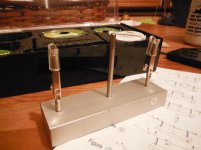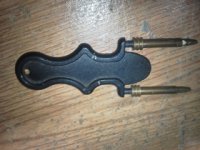Years back there was a Big Flat Brook regular named John Selazie who invented a little tool for tying Blood Knots. John was a machinist by trade and he has been deceased for many years.
John's tool measures 3/4" X 3/4' X 1/4" and has two brass spring-loaded pins with heads on its top 1/4" side. Along each wide side at the top are fastened clips for holding the two strands of monofilament.
I recently obtained one of John's knot tyers and I've been fooling around with it. However, eventhough he used to demonstrate it for us I can't remember how it's done.
My sincere thanks to anyone out there who can post or pm instructions for me.
John's tool measures 3/4" X 3/4' X 1/4" and has two brass spring-loaded pins with heads on its top 1/4" side. Along each wide side at the top are fastened clips for holding the two strands of monofilament.
I recently obtained one of John's knot tyers and I've been fooling around with it. However, eventhough he used to demonstrate it for us I can't remember how it's done.
My sincere thanks to anyone out there who can post or pm instructions for me.


